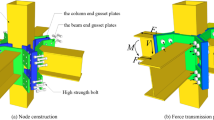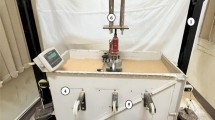Abstract
Anchor cables are now widely used to stabilize many kinds of geostructures in practice. However, the prediction of the anti-pullout performance of anchor cables still involves uncertainty for designer. This paper presents an analysis procedure for the evaluation the ultimate pullout capacity of anchor cables embedded in rock. A unified rupture shape model is proposed to describe the failure surface shape of anchor in rock mass by incorporating typical failure mode and failure surface shape. Using the limit equilibrium method, a formula of ultimate pullout capacity of a single anchor (cable) considering layout pattern, grouting pressures, rock masse quality and construction disturbance is then established with the assumption that surrounding rock follows the generalized Hoek–Brown criterion. Performance of the present method is assessed using comparison of the theoretical and well-documented filed test results. Parametric study is also carried out to clarify the influence of some key indices for rock mass on the ultimate pullout capacity of anchor cables embedded in rock. The present analyses shows that the geological strength index has great influence on ultimate pullout capacity of a single cable and ultimate pullout capacity of a single cable could be improved to a certain extent by reducing construction disturbance.











Similar content being viewed by others
References
Ball A (1961) The resistance to breaking-out of mushroom foundations for pylons. In: Proceedings of 5th international conference on soil mechanics and foundation engineering, Paris, vol 1, pp 569–576
Bhattacharya P (2016) Pullout capacity of strip plate anchor in cohesive sloping ground under undrained condition. Comput Geotech 78:134–143
Bhattacharya P, Kumar J (2015) Uplift capacity of strip and circular anchors in soft clay with an overlay of sand layer. Geotech Geol Eng 33(6):1475–1488
BSI (British Standards Institution) (2000) Execution of special geotechnical work—Ground anchors. London, UK
Cai Y, Esaki T, Jiang Y (2004) An analytical model to predict axial load in grouted rock bolt for soft rock tunnelling. Tunn Undergr Space Technol 19(6):607–618
Deng Z, Leng W, Li Z, Liu X (2007) Calculation of ultimate bearing capacity of prestressed cable based on unified strength criterion. Chin J Rock Mech Eng 26(6):1138–1144
Deshmukh VB, Dewaikar DM, Choudhury D (2010) Computations of uplift capacity of pile anchors in cohesionless soil. Acta Geotech 5(2):87–94
Deshmukh VB, Dewaikar DM, Choudhary D (2011) Uplift capacity of horizontal strip anchors in cohesionless soil. Geotech Geol Eng 29:977
Ghaly A, Hanna A (1994) Ultimate pullout resistance of single vertical anchors. Can Geotech J 31(5):661–672
He S, Wang C (2004) Study on failure characteristics and ultimate pullout force of prestressed cable. Chin J Rock Mech Eng 23(17):2966–2971
He JQ, Xiao L, Zhang WY, Gao WH (2016) A method for calculating ultimate pull-out capacity of rock bolt based on modified Mohr–Coulomb failure criterion. Chin J Rock Soil Mech 37(09):2484–2488
Hoek E, Brown ET (1980) Empirical strength criterion for rock masses. J Geotech Eng Div ASCE 106(GT9):1013–1035
Hoek E, Brown ET (1997) Practical estimates of rock mass strength. Int J Rock Mech Min Sci 34(8):1165–1186
Hoek E, Wood D, Shah S (1992) A modified Hoek–Brown failure criterion for jointed rock masses. In: Proceedings of rock characterization symposium, Int. Soc. Rock Mech.: Eurock ‘92, J. Hudson ed, London. Thomas Telford Publishing, pp 209–213
Hoek E, Carranza-Torres CT, Corkum B, Hoek E, Carranza-Torres C (2002) Hoek–Brown failure criterion—2002 edn. In: Narms-Tac conference, Toronto, pp 267–273
Kim HK, Cho NJ (2012) A design method to incur ductile failure of rock anchors subjected to tensile loads. Electron J Geotech Eng 17:2737–2746
Kou HL, Guo W, Zhang MY (2015) Pullout performance of GFRP anti-floating anchor in weathered soil. Tunn Undergr Space Technol 49:408–416
Littlejohn GS, Bruce DA (1975) Rock anchors: State-of-the-Art. Part I, Design, Ground Engineering. Foundation Publications Ltd, Essex, England
Ma S, Nemcik J, Aziz N (2013) An analytical model of fully grouted rock bolts subjected to tensile load. Constr Build Mater 49(1):519–526
Merifield RS, Lyamin AV, Sloan SW (2003) Three-dimensional lower-bound solutions for the stability of plate anchors in sand. J Geotech Geoenviron Eng ASCE 129(3):243–253
Meyerhof G, Adams J (1968) The ultimate uplift capacity of foundations. Can Geotech J 5(4):225–244
Nemcik J, Ma S, Aziz N, Ren T, Geng X (2014) Numerical modelling of failure propagation in fully grouted rock bolts subjected to tensile load. Int J Rock Mech Min Sci 71:293–300
Ng CWW, Yau TLY, Li JHM, Tang WH (2001) Side resistance of large diameter bored piles socketed into decomposed rocks. J Geotech Geoenviron Eng ASCE 127(8):642–657
Nie W, Zhao ZY, Ning YJ, Guo W (2014) Numerical studies on rockbolts mechanism using 2D discontinuous deformation analysis. Tunn Undergr Space Technol 41(1):223–233
Obata M, Inoue M, Goto Y (1998) The failure mechanism and the pull-out strength of a bond-type anchor near a free edge. Mech Mater 28(1):113–122
Pain A, Choudhury D, Bhattacharyya S (2015) Seismic uplift capacity of horizontal strip anchors using a modified pseudodynamic approach. Int J Geomech. https://doi.org/10.1061/(asce)gm.1943-5622.000047
Rangari SM, Choudhury D (2013) Computations of seismic passive resistance and uplift capacity of horizontal strip anchors in sand. Geotech Geol Eng 31(2):569–580
Ren FF, Yang ZJ, Chen JF, Chen WW (2010) An analytical analysis of the full-range behaviour of grouted rockbolts based on a tri-linear bond-slip model. Constr Build Mater 24(3):361–370
Serrano A, Olalla C (1999) Tensile resistance of rock anchors. Int J Rock Mech Min Sci 36(4):449–474
Serrano A, Olalla C (2006) Shaft resistance of piles in rock: comparison between in situ test data and theory using the Hoek and Brown failure criterion. Int J Rock Mech Min Sci 5(43):826–830
Serrano A, Olalla C, Galindo RA (2015) Shaft resistance of a pile in rock based on the modified Hoek–Brown criterion. Int J Rock Mech Min Sci 76:138–145
Yang Y, Yu HS (2010) Finite element analysis of anchor plates using non-coaxial models. J Rock Mech Geotech Eng 2(2):178–187
Zhang QQ, Feng RF, Liu SW, Li XM (2018a) Estimation of uplift capacity of a single pile embedded in sand considering arching effect. Int J Geomech 18(9):06018021
Zhang QQ, Liu SW, Feng RF, Li XM (2018b) Analytical method for prediction of progressive deformation mechanism of existing piles due to excavation beneath a pile-supported building. Int J Civ Eng. https://doi.org/10.1007/s40999-018-0309-9
Zhao Y, Yang M (2011) Pull-out behavior of an imperfectly bonded anchor system. Int J Rock Mech Min Sci 48(3):469–475
Acknowledgements
This work was supported by the National Natural Science Foundation of China (Nos. 51778345; 41877252), the Shandong Provincial Natural Science Foundation for Distinguished Young Scholars (No. JQ201811), the Key Laboratory of Geotechnical and Underground Engineering of the Ministry of Education (Tongji University) (No. KLE-TJGE-B1802), and the Young Scholars Program of Shandong University (No. 2017WLJH32). Great appreciation goes to the editorial board and the reviewers of this paper.
Author information
Authors and Affiliations
Corresponding author
Additional information
Publisher's Note
Springer Nature remains neutral with regard to jurisdictional claims in published maps and institutional affiliations.
Rights and permissions
About this article
Cite this article
Zhang, Qq., Feng, Rf., Xu, Zh. et al. Evaluation of Ultimate Pullout Capacity of Anchor Cables Embedded in Rock Using a Unified Rupture Shape Model. Geotech Geol Eng 37, 2625–2637 (2019). https://doi.org/10.1007/s10706-018-00782-0
Received:
Accepted:
Published:
Issue Date:
DOI: https://doi.org/10.1007/s10706-018-00782-0




